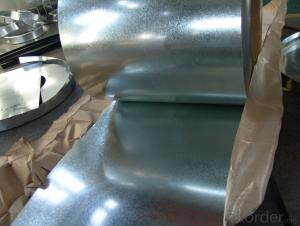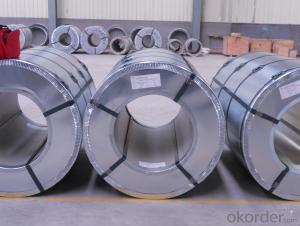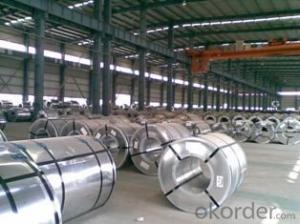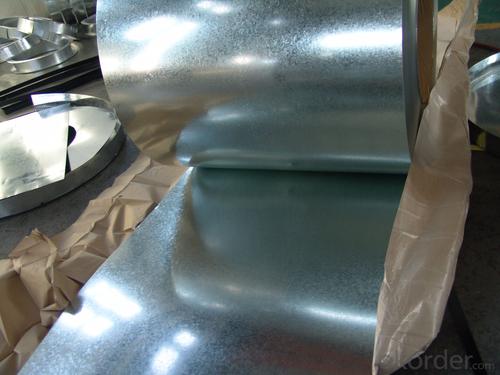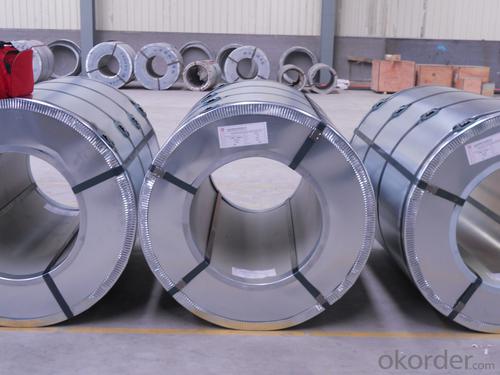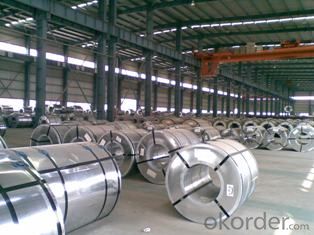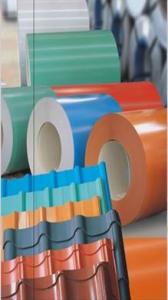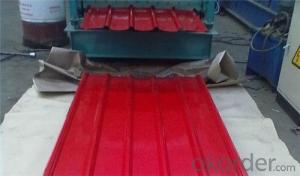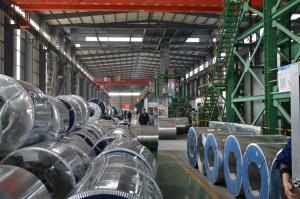Hot-dip Galvanized Steel Coils
- Loading Port:
- China Main Port
- Payment Terms:
- TT OR LC
- Min Order Qty:
- -
- Supply Capability:
- -
OKorder Service Pledge
OKorder Financial Service
You Might Also Like
Specifications:
Product name | Hot-dip Galvanized Steel Coils |
Thickness | 0.2mm-2.0mm |
Width | 900mm,914mm,1000mm,1200mm,1250mm,1500mm |
Zinc coating | 40g-275g |
Standard | ASTM, AISI, JIS, GB |
Material | SGCC,DC51D,DX51D,DX52D,SPCC,SGCD,Q195,SGHC |
Surface structure | zero spangle, regular spangle or minimum spangle |
Surface treatment | Chromate treatment, Oiled/dry, skinpassed/non-skinpassed |
Packing | Standard seaworthy export package |
Payment | T/T or L/C |
Min order | 50 ton/tons |
Delivery time | within 35 days upon receipt original L/C or advance payment |
Application
Construction | the building roof plate, roof grille etc. |
Light industry | the home appliances with its shell, civil chimneys, kitchen appliances etc. |
Automobile | corrosion resistant parts of car etc. |
Farming livestock and fishing | food storage tools; frozen processing equipment of meat and aquatic products etc. |
Commerce | storage and transportation of materials, packaging equipment etc. |
- Q: What are the different methods of punching steel coils?
- There are several methods of punching steel coils, including mechanical punching, hydraulic punching, and laser punching. Mechanical punching involves the use of a mechanical press with a punch and die set to create holes or shapes in the steel coil. Hydraulic punching utilizes hydraulic force to drive a punch through the coil, providing high precision and speed. Laser punching, on the other hand, uses a laser beam to cut or form holes in the steel coil, offering great flexibility and accuracy. Each method has its own advantages and suitability depending on the specific requirements of the application.
- Q: How are steel coils used in the production of metal enclosures?
- Due to their versatility and strength, steel coils find extensive use in the manufacturing of metal enclosures. Typically made from high-quality steel, these coils serve as the primary raw material for producing metal enclosures. To begin with, specialized machinery is employed to unroll and flatten the steel coils to the desired thickness. This step ensures that the coils are suitable for further processing. Subsequently, the flattened steel is cut into specific sizes and shapes, according to the design requirements of the metal enclosure. Following this, various techniques such as bending, folding, and welding are utilized to mold the cut steel pieces into the desired shape. These processes enable the steel to be formed into the required dimensions and structure of the metal enclosure. The inherent strength and durability of the steel coils ensure that the final product is robust and capable of withstanding external forces or impacts. Moreover, steel coils can be coated with protective layers such as galvanization or powder coating to enhance their resistance to corrosion, rust, and other environmental factors. This coating helps to extend the lifespan of the metal enclosure while maintaining its aesthetic appeal. Furthermore, the use of steel coils in the production of metal enclosures allows for customization and flexibility. The coils can be easily manipulated to create complex shapes or designs, facilitating the customization of enclosures to meet specific customer requirements. This adaptability makes steel coils a preferred choice in industries such as automotive, electronics, and construction, where metal enclosures are widely used. In conclusion, steel coils are essential in the manufacturing of metal enclosures as they provide a strong and versatile raw material. These coils are transformed into the desired shape and size, ensuring the durability and functionality of the enclosures. With their customizable nature and protective coatings, steel coils offer a cost-effective solution for producing high-quality metal enclosures.
- Q: How are steel coils used in the manufacturing of household goods?
- Steel coils are commonly used in the manufacturing of household goods as they are shaped and processed into various components such as frames, springs, and supports. These coils provide strength, durability, and stability to items like furniture, appliances, and automotive parts, ensuring their longevity and functionality.
- Q: looking to buy a sashimi knife. what is the difference between white steel (1and2) and blue steel (1and2) in terms on characteristics. what gets sharper? what holds edge longer? basically any info on the pros and cons of each steel would be SO GREATLY APPRECIATED! thanks in advance to all who answer. i'm leaning towards white-2 steel for my first sashimi knife, started training on the sushi bar and need a new tool!
- Actually okorder /
- Q: How do steel coil manufacturers ensure employee safety?
- Steel coil manufacturers ensure employee safety through a combination of measures and protocols aimed at preventing accidents, promoting awareness, and providing appropriate training and protective equipment. Firstly, manufacturers conduct regular safety audits to identify and rectify potential hazards in the workplace. This includes inspecting machinery, equipment, and facilities to ensure they meet safety standards and are properly maintained. To promote a culture of safety, manufacturers implement comprehensive safety training programs for all employees. These programs cover topics such as proper handling of equipment, safe material handling practices, and emergency procedures. Additionally, manufacturers provide ongoing training to employees to ensure they are up to date with the latest safety protocols and best practices. Personal protective equipment (PPE) is an essential component of employee safety in steel coil manufacturing. Manufacturers ensure that employees are provided with and trained on the proper use of PPE, including safety glasses, gloves, helmets, and protective clothing. Regular checks are conducted to ensure that PPE is in good condition and replaced as necessary. Manufacturers also implement engineering controls to minimize risks in the workplace. This may include installing safety guards on machinery, implementing automated systems to reduce manual handling, and using advanced technology to monitor and control potential hazards. Regular maintenance and inspections are conducted to ensure that these controls are functioning effectively. Furthermore, manufacturers maintain a strong emphasis on communication and employee involvement in safety programs. This includes encouraging employees to report hazards or near-miss incidents, conducting safety meetings and toolbox talks, and actively involving employees in safety committees or teams. Manufacturers also foster a supportive environment where employees feel comfortable reporting safety concerns or suggesting improvements. Overall, steel coil manufacturers prioritize employee safety through a combination of measures, including regular safety audits, comprehensive training programs, provision of PPE, implementation of engineering controls, and fostering a culture of communication and employee involvement. These efforts contribute to creating a safe and secure working environment for all employees.
- Q: What are the dimensions of steel coils used in bridge construction?
- The dimensions of steel coils utilized in the creation of bridges can fluctuate depending on the precise requirements of the bridge undertaking. However, in general terms, the dimensions of steel coils used in bridge construction typically fall within the range of 0.5 to 1 inch in thickness and 36 to 72 inches in width. The length of the coils may also differ, but is commonly around 20 to 40 feet. These dimensions enable the production of various fundamental structural elements, such as beams, columns, and plates, which are indispensable for bridge construction. It is noteworthy that the dimensions may vary based on the specific design and engineering specifications of the bridge project, as well as the type and load capacity of the bridge being constructed.
- Q: How are steel coils processed and shaped into various products?
- Steel coils are processed and shaped into various products through a series of manufacturing processes. First, the steel coil is uncoiled and cleaned to remove any impurities. Then, it goes through a process called leveling, where the coil is flattened and straightened. Next, the steel is cut into the desired length or shape, using techniques like shearing or slitting. After that, it may undergo additional processes such as forming, bending, or rolling to give it the desired shape. Finally, the steel is often treated with coatings or finishes to enhance its durability and appearance.
- Q: Is Stainless steel called that because.....a. Its stains lessORb. Its virtually stainless (it can't stain).Lol do you know the correct answer?????
- Stainless Steel is named that because when compared to untreated steel it is virtually stainless. It is virtually stainless, and harbors very little germs and bacteria. That is why it has been the standard in the food industry for years.
- Q: I'm in the process of buying a new car, and wondering if there are more benefits from Aluminum tire rims over Steel. Aluminum wheels cost more, but you'd think that steel would last longer. Are Aluminum wheels just for looks?
- aluminum is lighter , alot of performance cars use them to trim unsprung weight from the wheels ... steel wheels are cheaper but u have to put hub caps on them ... eeeeeuuuuueeewww!!!!!
- Q: I know that it is used for katanas and swords but what is it and is it good i am pretty sure that it is the process of the steel but can I have a little more information.
- It's a special type of steel that was made in Syria. It is used to make swords or knives. It's mostly used in Middle East and South Asia.
Send your message to us
Hot-dip Galvanized Steel Coils
- Loading Port:
- China Main Port
- Payment Terms:
- TT OR LC
- Min Order Qty:
- -
- Supply Capability:
- -
OKorder Service Pledge
OKorder Financial Service
Similar products
Hot products
Hot Searches
Related keywords
